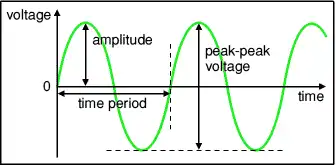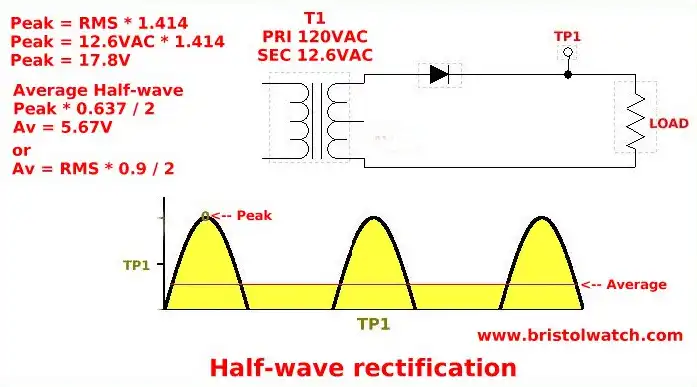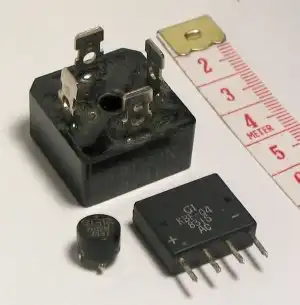
Fig. 1
Basic Power Supply Rectification Tutorial
by Lewis Loflin
Many devices, in particular solid state electronics, must use DC or direct current. A diode is a solid-state device that conducts in one direction only. When the anode (A) is positive and the cathode (K) is negative current flow from positive to negative will flow through the diode, through the load, and back to the power supply.
Thus current will flow only of the positive half-cycle (0 to 180 degrees) and the diode will shut-off during the negative half-cycle from 180 degrees to 360 degrees. The period of a sine wave from 0 degrees to 360 degrees equals 1/F. In the case of 60 Hertz it's 1/60 = 16.7 mSec.
What is power? Voltage (in volts) is the "push" and the current (in Amperes) is what is being pushed. (Electric charges) Power is voltage times current. Power is measured in watts.
So one amp at one volt equals one watt. (I'm not going into all of Ohm's Law here. See your text.) We must have voltage and current together to get power, so an open switch, broken wire, or a shut-off diode delivers no power.
In the case above, we get very poor power transfer with the diode off during the negative half-cycle and the positive half-cycle changing constantly between zero volts and peak. Note that Vmax is peak.

Figure 2
Let's say the AC in is 12.6 volts RMS. To get peak we multiply 12.6 by 1.414, which equals about 17.8 volts. But the average (or measured) voltage DC is peak times .3185 equals about 5.67 volts.
This is what is called pulsating DC. Pure DC, such as from a 12 volt auto battery, has none of the "ripple" and will be a real 12 volts.
Put a DC voltmeter across the load above in figure 1, one will read about 5.66 volts. Switch the meter to AC, one will still read a voltage of some value. This is normal as one is reading the "ripple" riding the unfiltered raw D.C. Connect the same AC voltmeter across a clean DC source such as a car battery, one will read zero volts AC.
In figure 2 we inserted a capacitor across the load. The capacitor charges during the positive half-cycle, then discharges through the load during the negative half-cycle when we have no output. The amount of ripple is dependant on the resistance of the load and the size of the capacitor.
A larger capacitor produces less ripple or a higher resistance load (drawing less current thus less time for the capacitor to discharge) will reduce the level of ripple because the capacitor has less time to discharge. With no load at all, just the capacitor and the rectifier, the capacitor will charge to peak.
A word of caution. If constructing these circuits observe capacitor polarity and diode polarity. The voltage ratings of the capacitors should exceed the expected peak voltage by 50%. Also note the current ratings of the transformers and diodes.

Figure 3
rectification
Full-wave rectification
Full-wave rectification converts both polarities of the input waveform to DC (direct current), and is more efficient. However, in a circuit with a non-center tapped transformer, four diodes are required instead of the one needed for half-wave rectification.
This is due to each output polarity requiring two rectifiers each. Four rectifiers arranged this way are called a diode bridge or bridge rectifier.
Note that in this example the arrows show conventional current flow, not electron flow I use with my students. This causes endless confusion for students as the military, etc. use electron flow in their training material while semiconductor classes use conventional current.
Just be aware of this as one follows this material. Electron flow is from negative to positive, conventional (or charge) flow is from positive to negative.
In figure 3 D1 and D2 conduct during the positive half-cycle while D3 and D4 conduct during the negative half-cycle. Power delivered here is twice that of half-wave rectification because we are using both half-cycles.
Using 12 volts AC again, we have 12.6 X 1.414 or 17 volts peak. (17.8 volts) But now to get the average we multiply by peak (17.8 volts) by 0.637 which equals 10.83 volts, double that of half-wave.
In addition we can use a smaller filter capacitor to clean out the ripple than we used with half-wave rectification. We have also doubled the frequency from 60 Hertz to 120 Hertz.
It should be noted that when this circuit is constructed the voltage on the meter will be about one volt low. This is due to a 0.6 volt drop across the diodes, meter calibration due to frequency change (from 60 Hz to 120 Hz), and calculation errors.

Figure 4 typical bridge rectifiers.

Figure 5
Figure 5 above illustrates another method to obtain full-wave rectification. In this case we use a center-tapped transformer and two diodes. In using the center-tap (C) as a common, the voltage A and B is 180 degrees out of phase.
When A is positive, D1 will be forward biased and conduct, while B will be negative thus reverse-biasing D2, while is non-conductive. On the negative half cycle in relation to A when D1 doesn't conduct, D2 will conduct.
It should be noted the output voltage will be cut by half. If we use a 25.2 volt, three amp transformer, the output voltage will be 12.6 volts. There is some controversy on output current. We are dealing RMS amps and have to factor in transformer impedance. (Z)
During each half-cycle in this configuration current flow in one-half the total windings. Based on resistance of the wire, Z, etc. the current can be 1.2 to 1.8 times the rated current.
I'd urge caution on these claims and wouldn't go above 1.4. All of the previous rules for peak, output voltage, etc. still hold true.
- Quick navigation of this website:
- You Tube Channel
- Basic Electronics Learning and Projects
- Basic Solid State Component Projects
- Arduino Microcontroller Projects
- Raspberry Pi Electronics, Programming
- Build Autotransformer-Variac AC and DC Power Supply
- Connecting Transformers in Series-Parallel
- Connecting Series-Parallel Batteries
- Connecting Transformers in Series-Parallel
- Build an Adjustable 0-34 volt power supply with the LM317
- AC Power Supply Rectification
- Basic Power Transformers
- Transistor-Zener Diode Regulator Circuits
- Tips for the LM78XX Series Voltage Regulators
- Bi-Polar Power Supplies
Related videos:
Basic Electronic Power Supplies Part 1
Basic Electronic Power Supplies Part 2
Build a low voltage DC power supply Part 3
AC Power Lab on Series Circuits Part 1
AC Power Lab on Series Circuits Part 2
- Photo Detector Devices:
- Photodiode Circuits Operation and Uses
- Photodiode Op-Amp Circuits Tutorial
- Photo Voltaic Tutorial MOSFET Output Solid State Relays
- Transistor Driver Circuits
- Opto-Isolated Transistor Drivers for Micro-Controllers
- MOSFET Transistors, IGBTs Observations
- Added Nov. 16, 2014
- ULN2003A Darlington Transistor Array with Circuit Examples
- Tutorial Using TIP120 and TIP125 Power Darlington Transistors
- Driving 2N3055-MJ2955 Power Transistors with Darlington Transistors
- Understanding Bipolar Transistor Switches
- N-Channel Power MOSFET Switching Tutorial
- P-Channel Power MOSFET Switch Tutorial
- More Power MOSFET H-Bridge Circuit Examples
- Build a High Power Transistor H-Bridge Motor Control
Web site Copyright Lewis Loflin, All rights reserved.
If using this material on another site, please provide a link back to my site.